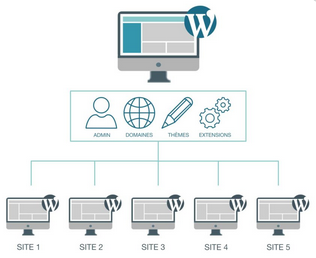
What is a WordPress multisite
WordPress Multisite is a feature that allows you to create and run multiple WordPress websites from a single WordPress dashboard. It was previously called WordPress Multi-User (WPMU). WordPress Multisite is not a new feature. This is an advanced feature on the WordPress platform that has been around since the launch of WordPress 3.0. You can use it for a variety of purposes, such as updating all your websites with one click or billing your subscribers to build a website on your multisite network.
Why you need to use a WordPress multisite
- WordPress Multisite = one installation, many sites. When using Multisite, you can create as many sites as you want under one URL. All of these sites will use the same theme, plugins and have access from a single hosting account. The domain names of the sub-sites will be based on the original URL.
- Single installation. If you host multiple WordPress sites with different accounts, you will need to install WordPress for each site separately. If you have a thousand different sites, do you really want to install WordPress a thousand times? Obviously not. When using Multisite, you only need to install WordPress once for the hosting site. Single install and you can host a million sites if you want.
- Share themes and plugins. If you need to change the original site’s theme and subsites, you can do in sync with the share feature. Multisite allows the hosting account to share themes and plugins with all the other websites in the network, which makes the task much easier. Plugins can easily be installed by site administrators or network administrator to be shared by everyone
- A WordPress multisite is affordable. Having a single hosting account for hundreds or thousands websites is not only convenient,but also affordable, especially for commercial sites that generate international traffic. Multisite is a very profitable option.
Who can benefit from a WordPress multisite
Although WordPress Multisite offers several features, it is not always the right choice. The main concern is that websites in a multisite network share the same database. In other words, you cannot back up a single website. Therefore, all websites on a network must be in the same primary domain.
Let’s explain this with an example. A university could use WordPress Multisite to create different websites for each department, for student and faculty blogs, and for forums. Because the websites would share their database with the university’s main domain, they would be easier to manage on a multisite network.
Likewise, banks and financial institutions with a national or global network of branches, digital publications with multiple content sections, government offices with multiple departments, hotel chains, stores with multiple outlets, E-commerce companies and web design companies such as Wix could also use a multisite network to their advantage.
However, a web designer cannot use Multisite to manage multiple independent client projects. If one of the customers decided to move their website elsewhere, that would be a problem as the website would share its database with others on the network. Multisite makes it difficult to back up an individual website on the network. You’d better use a single installation in this case.